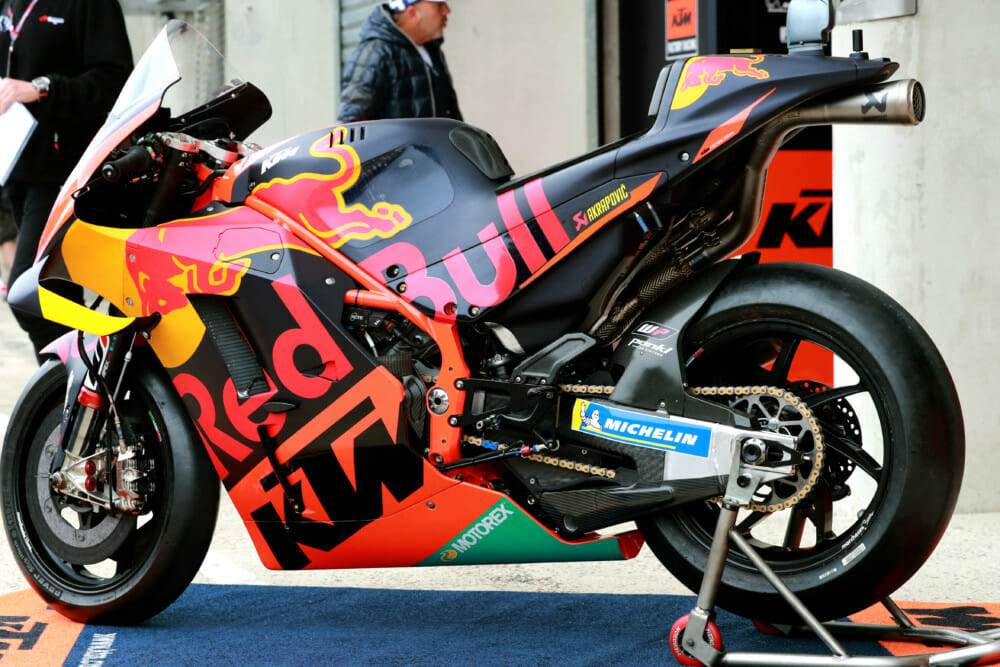Michael Scott | July 17, 2019
Cycle News In The Paddock
COLUMN
To Be Better, You Have To Start Off Good
How do you make the perfect racing bike? Back in the days of the two-stroke 500s, I recall legendary crew chief Kel Carruthers’ answer: “It’s what worked last year, plus a few percent.”
The answer today would be just the same.
In other words, to be able to improve enough to remain competitive, you need a good bike to start with. Which kind of makes it difficult for newcomers to catch up, as KTM and to a greater extent Aprilia are demonstrating all too clearly.
 The quest for better never ends.
The quest for better never ends.
At the same time, even if you are already strong, it isn’t always easy to find that few percent. And all the more so when rules freeze engine development during the season.
Both the dominant factories have demonstrated that. Honda got into quite a muddle after 2014—Marquez’s second season—when he won 11 of the first 12 races, and then two more into the bargain.
His RC213V was at a pitch of development that was already hard to improve upon, and then it was saddled with a control Magneti Marelli ECU, replacing Honda’s in-house hardware. As if that wasn’t bad enough, instead of biting the bullet and adopting Magneti Marelli software, which was to become compulsory in any case in 2016, HRC stubbornly set about applying their own software to this alien host.
As a result, 2015 was the only year since his arrival that Marquez didn’t win the title, and it made things difficult for 2016 and thereafter. HRC made several miss-steps, with first an over-light and then an over-heavy crankshaft. They made it harder for themselves with a new 90-degree vee-angle and a reverse-direction crank, all while getting used to the new unified software.
It took all Marquez’s genius to return to regain a stranglehold on the title from 2016 to 2018, while teammate Dani Pedrosa’s struggles became increasingly difficult. Marquez’s hardships were reflected in the number times he fell, a crescendo of crashes. He recorded 13 in 2015, 17 the next year, a crunching 27 in 2017, and a still impressive 23 last year. Almost all were in practice, because it was the only way he could be sure of defining the limits of a difficult and unpredictable motorcycle.
This year, just six so far, and he smilingly admits it’s because at last Honda has come up with a much better balanced motorcycle. It’s more powerful, but more importantly, less of a monster. “The strong points are not as much, but the weak points not so weak…at circuits where we struggled before, it is easier,” he said. “With more power, you don’t need to take so many risks in the braking.”
Yamaha’s problems is likewise all too evident, if hard to understand. The M1 has been missing the boat by increasing margins over the past couple of years. The dismay of Rossi and Vinales has increased hand in hand. It’s not far off the mark, but far enough to mean that this year yet again any championship hopes have already vanished.
Rossi is having a particularly tough time, although a newfound patience and positivity (along with a new crew chief) has at last started to pay dividends for Maverick, with a win and a podium in the last two races. From struggler to winner demonstrates just how small the margins can be.
Likewise at Ducati, whose bike has improved, but so far not by quite enough.
But what of the struggling newcomers?
Suzuki has shown that, freed for last year from the frozen-engine problem, you can get there. Now they’re with the factory opposition, in terms of both rules and performance.
The other two bear more scrutiny.
Aprilia has the furthest to climb but has made important steps this year by taking what nearly worked the year before last, plus a few percent.
KTM is the more improved, thanks to a huge budget, but in confusing ways. Their bike is maybe even more particular than the Honda that only Marquez could really manage. Pol Espargaro has taken five top 10s in the first nine races, and at almost every measurable opportunity has been significantly closer to the winner than last year. Most strikingly at Le Mans, where last year he was 11th and 32 seconds behind, this year sixth, 5.9 seconds away.
But new star recruit Johann Zarco has stumbled, fallen, stumbled and fallen, again and again. His tally of 11 tumbles this year is one more than the somewhat crash-happy Jack Miller, but at least Jack has been up at the sharp end. Former blazing Yamaha rookie Zarco has managed to score points six times, but usually only one or two.
KTM may be following Honda in making a bike that only works for one riding style. There are worse examples to follow than that. CN